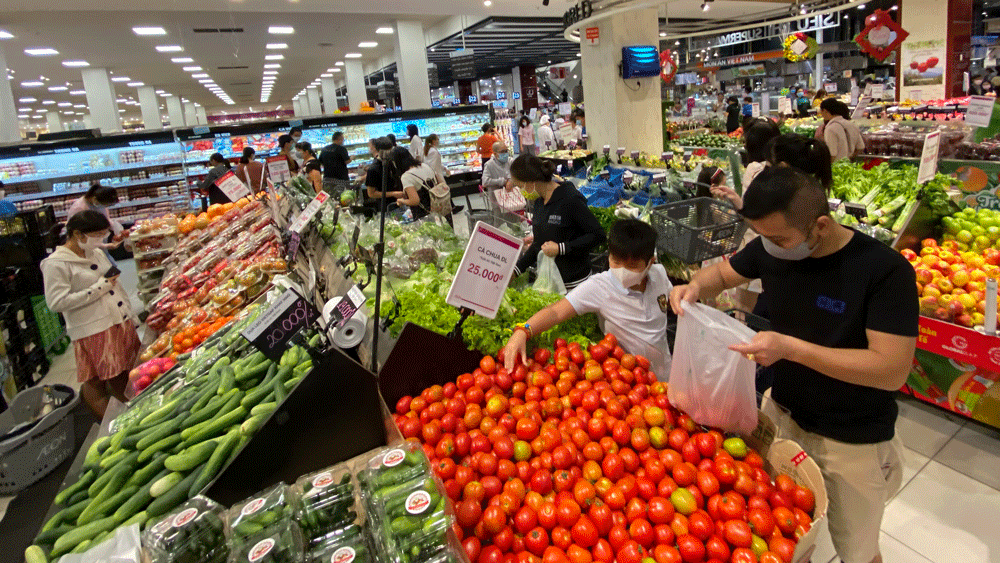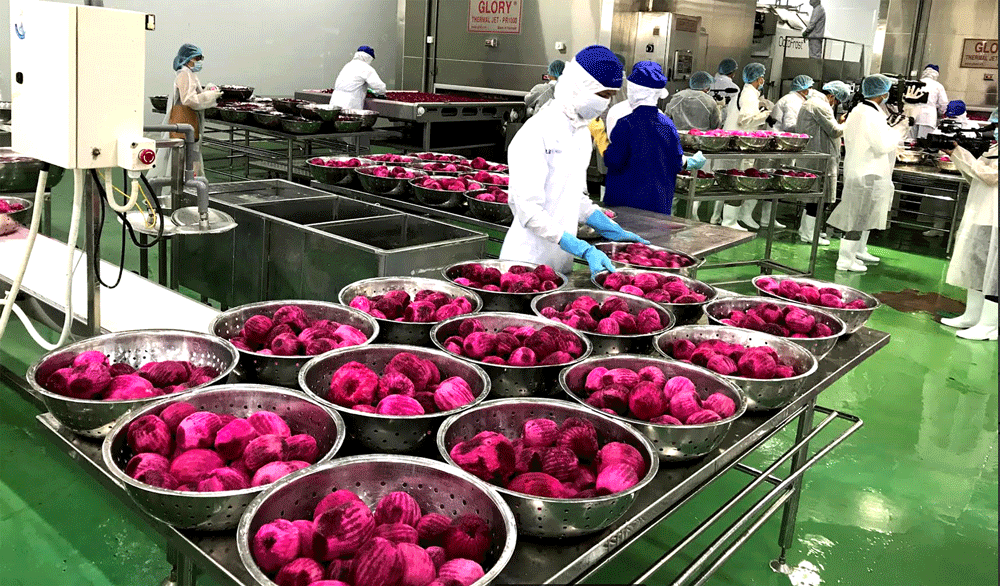
The latest field trip of Minister Nguyen Xuan Cuong of the Ministry of Agriculture and Rural Development to dragon fruit growing areas in Tien Giang and Long An provinces showed that fruits of cooperatives or farmers who grew fruits under contracts with enterprises were all purchased at previously-signed prices. For instance, the Vina T&T Company still bought durians and dragon fruits of orchards in Tien Giang Province. This company plans to put fruits into the fruit retail channel at supermarkets and freeze fruits at five cold storage warehouses, waiting for the Covid-19 outbreak to be controlled. To help with consumption, Vina T&T has purchased fruits for frozen storage with an amount 8-9 times higher than that at this time in previous years. The current difficulty is that cold storage warehouses of the company are already full so the company has to rent more warehouses of other companies to be able to keep buying fruits for farmers. The rental cost of refrigerated containers doubles that in the previous months to VND8-9 million per month, not including the power cost of around VND1 million per day.
Lavifood Company in Long An Province also bought more than 1,000 tons of dragon fruits from farmers at a price VND5,000 per kilogram higher than the market price to produce canned dragon fruit juice. This product will be launched to the domestic market and exported. Agricultural minister Nguyen Xuan Cuong said that this is the model of the association between farmers and enterprises that reduces risks for farmers, as well as showing the necessity of balancing the export of fresh agricultural products and the processing of agricultural products, contributing to increasing the value of products and helping to solve the excess of a certain type of agricultural products in peak harvest season. Once these association models are widely expanded, the situation of spontaneous rescue will gradually reduce.
Lavifood Company in Long An Province also bought more than 1,000 tons of dragon fruits from farmers at a price VND5,000 per kilogram higher than the market price to produce canned dragon fruit juice. This product will be launched to the domestic market and exported. Agricultural minister Nguyen Xuan Cuong said that this is the model of the association between farmers and enterprises that reduces risks for farmers, as well as showing the necessity of balancing the export of fresh agricultural products and the processing of agricultural products, contributing to increasing the value of products and helping to solve the excess of a certain type of agricultural products in peak harvest season. Once these association models are widely expanded, the situation of spontaneous rescue will gradually reduce.
 Dragon fruits are processed into canned dragon fruit juice at Lavifood Company in Long An Province. (Photo: SGGP)
Dragon fruits are processed into canned dragon fruit juice at Lavifood Company in Long An Province. (Photo: SGGP)
Mr. Dang Ngoc Can, CEO of Lavifood, said that the current biggest obstacle for enterprises is capital to buy agricultural products and rent warehouses. According to Mr. Vo Tan Hoang Van, CEO of Saigon Commercial Bank, to meet arising financial needs, especially amid the current context, the State needs to have a specific policy to give financial support for this sector. Especially leading enterprises that need to borrow money to develop factories, warehouses, logistics networks to develop agriculture sustainably and adaptively to market changes. The State needs to have a feasible policy, enabling more enterprises to participate in connecting material growing areas of a certain type of agricultural product, not only for export but also for domestic consumption. At the same time, the State needs to strictly control the situation that Chinese traders arbitrarily enter material growing areas to establish purchasing stations, competing with domestic enterprises but when agricultural products are excessive, they run away.
Leaders of Long An Province proposed the Ministry of Agricultural and Rural Development to promote the establishment of a distribution center for agricultural products in China which plays as a hub in trade with domestic enterprises to reduce risks; to preside the plan to associate provinces in spreading dragon fruit crop to avoid overproduction. This is a notable proposal.
Mr. Nguyen Lam Vien, Chairman cum CEO of Vinamit Joint Stock Company, an experienced businessman in agricultural product processing and exporting, said that the establishment of a distribution center for agricultural products in Taiwan or in the US appeared long ago. However, firstly, these distribution centers are built at concentration material growing areas. These centers are well-invested in the logistics system to create favorable conditions in purchasing, preserving, and transporting. These will be the place to classify, process, pack or send agricultural products to cold storage warehouses. These centers are usually organized by product lines’ associations, farmers’ associations or enterprises under the supervision of local authorities or relevant departments to eliminate the situation of an interest group or arbitrate price conflict between growers and buyers. Meanwhile, the agricultural sector is responsible for arranging farmers, via cooperatives, to produce a certain agricultural product, following farming process, ensuring requirements on food safety and traceability. When agricultural products need rescuing, enterprises will come to these centers to buy for processing or stockpiling.
Ministries and departments also made efforts in negotiations to quickly help Vietnamese fruits and agricultural products to enter choosy markets, such as the US, Japan, South Korea, Australia, the EU, New Zealand, and Chile. Owing to that, the number and types of export fruits, including dragon fruit, longan, mango, star apple, and lychee, will increase ceaselessly. Unfortunately, it usually takes 2-3 years or even 5-7 years to open a market for a certain type of fruit due to various procedures and requirements.
The disadvantage of these markets is long distance. Transporting by sea takes lots of time so the quality of vegetables and fruits is reduced easily while transporting by air makes the cost increase. Meanwhile, China is a large consumer market and is tightening requirements on quality and traceability. Therefore, besides diversifying export markets, China will remain the largest agricultural product importer of Vietnam. Enterprises should quickly adapt to new requirements on the quality and food safety of this market.
























